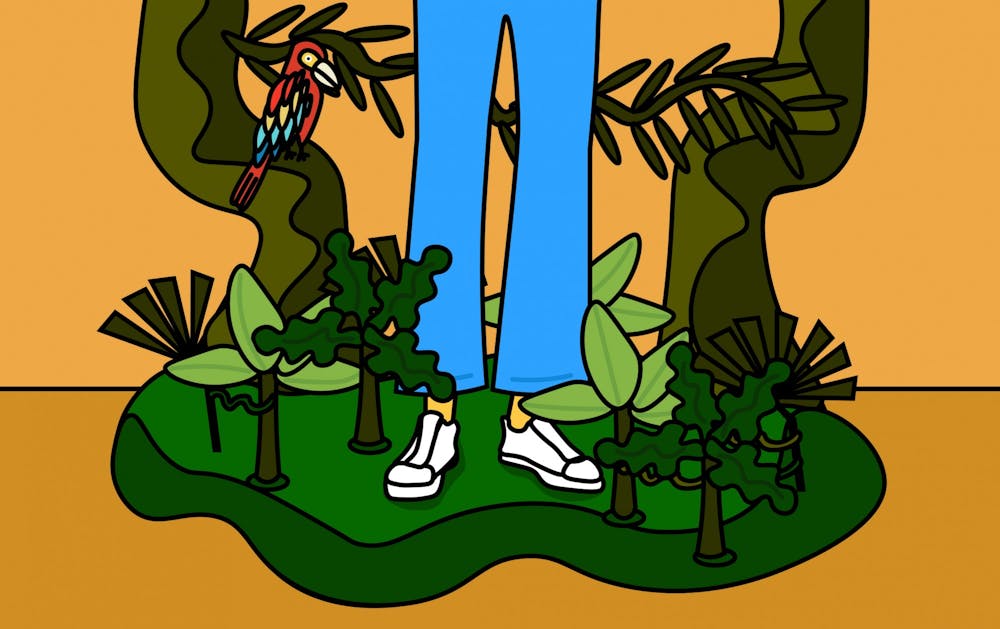Since 2015, the Center for Education Through eXploration has offered virtual field trips that transport users across time and space to learn about science.
What began with simple video clips evolved into 360-degree immersive experiences complete with footage from locations across the globe and commentary from experts on topics like geology, biodiversity and astrobiology, available for use by learners around the world.
The latest of these is Surviving Extinction, a choose your own adventure-style learning experience that takes users back in time 350 million years to explore how different animals evolved or went extinct from then to now.
Geoffrey Bruce is the chief software architect at ETX and lead developer of Surviving Extinction.
One of Bruce’s main focuses when developing the adventure was making the learning experience something people would be invested in.
"We live in a state of me, you know, the generations have the Facebooks and the Twitters and it's all about me, me me,” Bruce said. “So how do you make learning about them? How do you make it something they have to go through?"
Bruce's solution was to turn the learning experience into a game of sorts.
In the beginning of Surviving Extinction, users choose a modern day animal and work to find the evolutionary pathway between that animal and the tetrapod—the common ancestor of amphibians, mammals and reptiles, including dinosaurs.
Along the way, users earn points, find “keys” to solve challenges and interact with other animals in order to complete the path and learn more about their animal’s evolution.
“When you get done, you don't really realize that you've just learned a whole bunch,” Bruce said. “The comments coming back are, ‘Wow, that was amazing, I've learned a whole bunch, I can't wait to use this with my students,’ those types of things, which is really exciting.”
Each modern-day animal has its own pathway with different challenges than the others, giving users the chance to keep playing after they’ve completed the first pathway.
Bruce said the first pathway takes about an hour to complete, the second half an hour and each additional pathway 15-30 minutes. Completing more than one pathway allows users to discover more keys and find connections between the animals’ paths.
The immersive nature of the experience offers a learning experience that goes beyond memorization and into a deeper, more lasting understanding of the information.
“I'm really interested in teaching something that gets (people) excited enough to commit that to their own learning so that they can take that with them and build on that in the future,” Bruce said.
Surviving Extinction and the other virtual field trips offered through ETX are available for free online, and there are more currently in development.
Ariel Anbar, director at ETX, said one of his favorite things about the virtual field trips is their ability to make remote and distant locations accessible to people from their computers.
“I think it's really cool when you can put somebody into this virtual environment, to a location they've never been in or even thought about, and see them get excited about it,” Anbar said. “I don't mean to say that the virtual is better, but there are occasions where it makes possible conversations and learning that is very, very difficult to do in person.”
In the future, when it becomes more universally accessible, Anbar hopes to incorporate true 3D virtual reality technology into the experiences. He also hopes to create collaborative learning experiences for groups to work on together.
Now that classes are required to be held online because of COVID-19, Anbar predicts learning experiences like the virtual field trips will become more common.
“Even if 80% of the people who are now faculty who are now teaching online conclude, ‘Wow, this is awful and I can't wait to get back to teaching the way I used to,’ 20% are going to say, ‘Hmm, this is not as bad as I thought,’” Anbar said.
“Or, you know, ‘This isn't great, but I could see how it could be great if we could do this, this, this and this.’ And one of the this’s is virtual field trips and virtual experiences.”
Julia Johnson, a senior lecturer in the School of Earth and Space Exploration, has used ETX’s virtual field trips in her online historical geology course for two years. “It’s kind of the highlight of the online class,” she said.
Johnson said she has led several webinars to inform other instructors of the virtual field trips and expects they will become more popular, especially since classes moved online.
“The feedback I get from students is that they learned a lot from them and enjoyed that particular part of the class to just sit back and watch these videos,” Johnson said.
Reach the reporter at gforslun@asu.edu and on Twitter @GretaForslund.
Like The State Press on Facebook and follow @statepress on Twitter.




